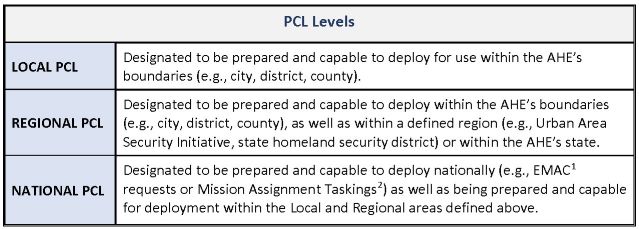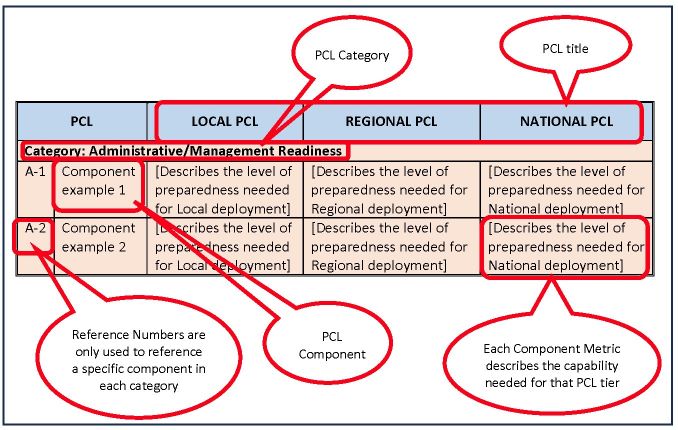Implementation and Management
Overview
The 3-Tiered Team Preparedness System (3TTPS) for All-Hazards Incident Management Teams (AHIMTs) is a widely accepted peer-developed and -managed national best-practice methodology for quantifying and standardizing the level of preparedness an AHIMT should possess to be able to deploy successfully in the geographic area of operation the AHIMT’s governance document identifies. The 3TTPS helps ensure that an AHIMT’s level of preparedness in the administrative, logistical, and operational areas aligns with peer-developed national preparedness and capability standards. The standardized national preparedness levels were originally referred to as Tiers, however, to avoid confusion with FEMA’s Preparedness Toolkit’s use of the same term, the 3TTPS now refers to these as Preparedness Capability Levels (PCLs).
The concept of developing a 3-Tiered Team Preparedness System was originally introduced in 2018. Based on significant research, dozens of draft documents were reviewed by stakeholders over the next few years until the concept was finally approved on September 29, 2022. Detailed information on the research, history, and concepts included is posted on the 3-Tiered Team Preparedness System Concept page.
How the Preparedness Capability Levels were developed
The function, degree, and scope of the assignments that an AHIMT will deploy to or accept is determined by the AHIMTs Hosting Entity (AHE) that authorized the AHIMT(s) formation, management, and governance. In their governance documents, the AHE should document the operational structure, limitations, and constraints, as well as defining the geographic area of operation they will permit or enable their AHIMT to deploy to in response to a request. Research demonstrated that existing AHEs had defined or described three types of geographic areas of operation or operational areas their AHIMT would deploy within. The three AHEs’ geographic areas of operation were determined to be the best identifiers for describing and differentiating the levels of the 3TTPS. The 3TTPS incorporated the AHE’s descriptions into three Preparedness Capability Levels (PCLs).

The individual components that make up the overall preparedness capability an AHIMT should meet in each PCL level identified was based on research, interviews, After-Action Reports from AHIMTs, and discussions with the entities that requested those AHIMT resources.
Implementing and Managing the 3TTPS
The link below will download the Implementation and Management Plan in a separate browser tab. The Plan describes the roles and responsibilities of the 3TTPS users, the relationship of the 3TTPS to the other USFA/AHIMTA and FEMA guidance and initiatives, the implementation phases, and the process for updating the 3TTPS guidance. The overall 3TTPS system includes two appendices, appendix A and B, that provide the specifics of each PCL, the preparedness capability that needs to be achieved in each component of the category, and descriptions of how a team can meet the intent of the component.
Appendix A – The Preparedness Matrix
Appendix A , The 3TTPS Preparedness Metrics Chart, organizes the components needed in each Preparedness Capability Level (PCL) into the categories of Administrative/Management Preparedness, Operational Preparedness, and Logistical Preparedness. It then describes the degree of preparedness needed to be achieved for each component of the PCL for a team be be considered as having met that preparedness capability level.
The layout and organization of appendix A is included in the implementation plan, as the first page of Appendix A, and is shown below.

The link below downloads the latest version of Appendix A, The 3TTPS Preparedness Metrics Chart, in a separate browser tab.
Appendix B
Appendix B, Metric Descriptions and Details, provides the details, conditions, and benchmarks that are part of the desired outcome or result.
Intent – Use Descriptive Performance Standards versus Prescriptive Performance Standards
The intent is that the standards will, when appropriate, be based on descriptive performance based benchmarks for an AHIMT to achieve rather than providing prescriptive lists (i.e. make and model number) of specific tools, supplies, equipment, and processes they must obtain or use. The places the focus on successfully meeting the performance benchmark, not just purchasing a specific list. Descriptive Performance Standards provide an AHIMT the latitude to look at best practices and alternatives rather than being constrained by specific brand and model numbers.
A comparison of the two standards are:
Example of a Prescriptive Performance Standard for a jacket
Jacket. Must be [brand name] or [brand name]: Model number [12345,] “SupraCold” model. Must include optional waterproof outer shell for garment, inner liner of down with a minimum of 6 oz of filling per square foot of fabric. Include optional removable washable liner.
Example of a Descriptive Performance Standard for a jacket
Jacket. Must be designed for use during physically demanding work in extreme weather. Must be capable of protecting the wearer from heavy rains, blowing snow, and temperatures of 20 degrees Fahrenheit. The waterproof outer shell and integrated hood should resist cuts and tears from sharp objects often encountered at accident scenes or debris from tornadoes and hurricanes. Garment should be designed with a removable liner for laundry cleaning without specialized chemicals or processes.
The link below downloads the latest version of Appendix B, Metrics Details and Examples, in a separate browser tab.
Help for AHIMTs in the development phase
The Model Documents Library
AHIMTs in the development phase or who are planning to move from one PCL to another (e.g. Local PCL to Regional PCL) often need suggestions, ideas, or examples of the equipment, supplies, cache, or tools that other AHIMTs have found as either essential or useful to meet the Descriptive Performance Standards found in appendix B. In the coming months, a library of best practice and sample model documents will be assembled and made available in a Model Document Library.